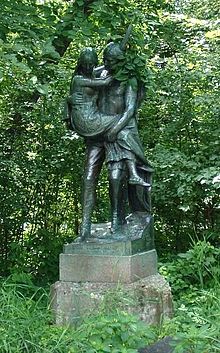The Song of Hiawatha
![]()
This article or subsequent section is not sufficiently supported by evidence (e.g., anecdotal evidence). Information without sufficient evidence may be removed in the near future. Please help Wikipedia by researching the information and adding good supporting evidence.
The Song of Hiawatha (in English original The Song of Hiawatha) is a long poem in the form of an epic, written by Henry Wadsworth Longfellow (1807-1882). It tells of the life of Hiawatha, an Indian who lived in the 16th century.
After an introduction, 22 sections describe Hiawatha's life from his childhood to his marriage to Minnehaha to his death. In the process, Longfellow also wove in other legends of the Indians.
It is precisely the inclusion of further legends, but also the metrics of the work, that are reminiscent of the Finnish national epic Kalevala. An influence is quite possible, since Longfellow had probably learned some Finnish a few years before writing his poem, but later also had access to a translation of the Finnish work.
This poetry of Longfellow's was musically processed in the symphony From the New World by Antonín Dvořák.
In 1900 the English composer Samuel Coleridge-Taylor set three scenes, namely Hiawatha's wedding, the death of the Minnehaha and Hiawatha's departure in three cantatas for orchestra, choir and soloists.
Walt Disney adapted the character in 1937 for the Silly Symphonies in the animated film Little Hiawatha, known in Germany as Klein Adlerauge. A comic series of the same name also appeared at irregular intervals in the Mickey Mouse magazine series.
In 1972, the composer duo Chinn/Chapman included Hiawatha in the glam rock song Wig-Wam Bam by the English group Sweet. Mike Oldfield also used parts of the Hiawatha poem for his album Incantations in 1978.

Hiawatha and Minnehaha, sculpture by Jacob Fjelde in Minnehaha Park in Minneapolis.
Search within the encyclopedia